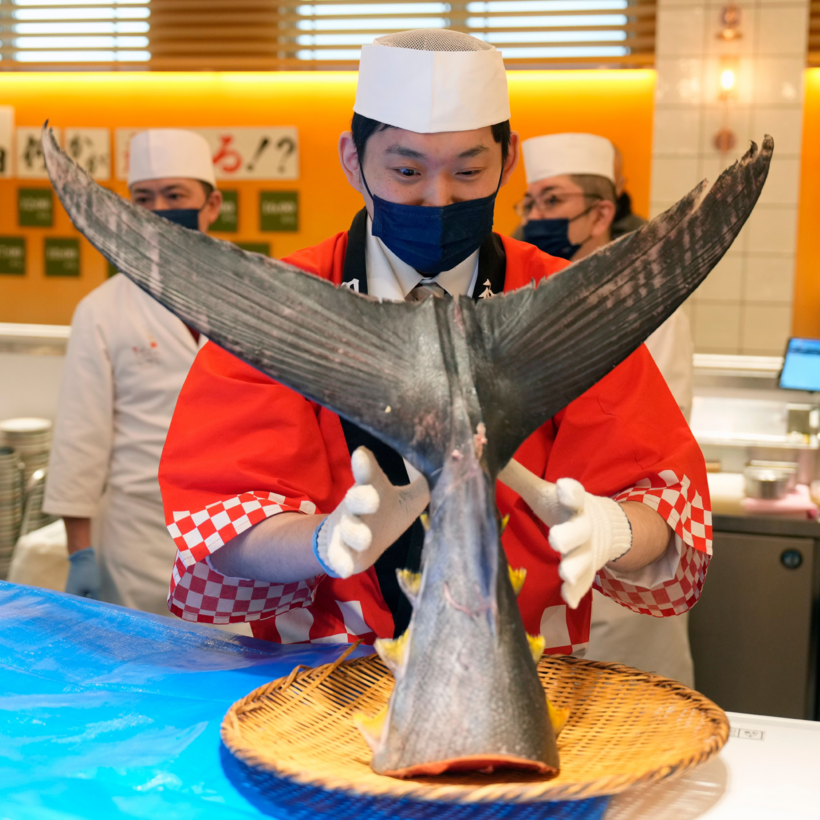Stepping from the pre-dawn darkness into Tokyo’s newly built Toyosu fish market, a bluefin-tuna buyer named Kiyoshi Kimura walks the glossy green floors. He weaves between rows of silver-bellied, gape-mouthed maguro, or bluefin, some weighing hundreds of pounds. In his hand, he holds a plastic flashlight, which he’ll shine through the flesh of each fish—the green backdrop makes it easier to evaluate their quality—before smearing the samples between his fingertips.
Today, the temperature-controlled auction floor teems with schooling groups of men on cell phones, each wearing knee-high rubber boots and a baseball hat punctuated with a numbered bidding placard of white or yellow plastic. Some carry wooden-handled or metal gaffs, designed for grabbing and dragging huge fish across the slick ground. To a bystander, it might look chaotic, but this is the daily ballet that occurs here at Toyosu, the world’s largest and most lucrative market for fresh bluefin tuna.
Each of Kimura’s bids is a gamble, he says. His samples, cut from the tail section, don’t always reveal flesh that is discolored, bruised, or spotted with blood. “When I get a bad tuna, my morale goes down,” says Kimura, who has worked at Tokyo’s fish auction for 25 years, including at the renowned Tsukiji fish market, which shuttered in 2018. “I still don’t believe I have mastered tuna yet,” he says, wincing modestly, with a downward nod of his head.
The auction begins at 5:30 a.m. sharp, as the auctioneer, standing on a small stool and wielding a brass bell, accepts bids flashed by teyari hand gestures and finger flicks. Each tuna sells within seconds, after which market employees slap large square labels on the tuna’s flanks. Nearby, forklift-driving workers hoist huge foam boxes, each filled with ice and a single, massive fish.
“When I get a bad tuna, my morale goes down.”
Some intermediate wholesalers, buyers such as Kimura, will section up each bluefin, selling its upper, lower, and middle belly cuts to different customers. On the other side of the cavernous space, up to 1,000 hard-frozen Atlantic bluefin lie on pallets. Those fish were caught and fattened in the Mediterranean, then killed and deep-frozen at minus 60 degrees Celsius before being loaded into freezer ships and making a long, slow journey halfway around the world. More than 1,400 tons of seafood passes through this market daily, and bluefin tuna is, on many days, its highest-earning species.
Watching the bustle through massive glass windows, a gaggle of tourists are disappointed to discover that, unlike the old market, where bystanders could often sneak onto the auction floor undetected, they must remain on the viewing platform. It’s more sanitary, their guide says, and prevents distracted lookie-loos from getting hit by machinery: a small price paid to modernity.
By the time the morning’s 200 or so fresh tuna are all auctioned off, the tourists start to get restless. “Let’s go eat breakfast sushi!” exclaims one young man in a red puffy jacket. Satisfied with their selfies, his group happily obliges, stepping into a gleaming elevator that whisks them away.
They arrive a few floors above the auction at the Sushi Dai restaurant, where a hopeful crowd has waited since three a.m., perched on round, white metal stools, scrolling on phones and blearily chatting. They’ve waited hours for this morning’s omakase breakfast, eagerly anticipating a parade of raw seafood draped atop clouds of seasoned sushi rice.
This morning’s meal, which costs 4,800 Japanese yen, or about $33, proceeds in a riotous array of flavors and textures: a marbled tranche of Wagyu beef, followed by sea bass, yellowtail, horse mackerel, and a denuded shrimp so fresh its fanlike tail still twitches. The itamae, or sushi chef, passes each piece over the glass-and-steel fish case, plopping it soundly onto a black-lacquered wooden ledge.
His razor-sharp knife glints, dropping downward through two-week-aged, marinated maguro cut from the tuna’s back, followed by Spanish mackerel, clams, and shiso, before rising to a crescendo of abalone, translucent scallops, and—ordered as an add-on—two additional cuts of bluefin. Waiting in line, it turns out, really whets the appetite.

Karen Pinchin’s Kings of Their Own Ocean: Tuna, Obsession, and the Future of Our Seas is out now from Dutton

